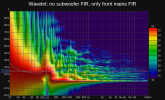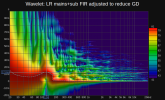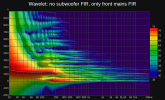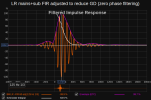Does you file clip a lot?I believe your math is correct, but do the tone signal are actually long enough in musical content?
I just pulled out Izotope RX on an audio file which max true peak level is -0.04 dB FS and applied a phase shift of -45deg, the max true peak level is then +3.08 dB FS. This is actually more of a difference than I anticipated.
-
WANTED: Happy members who like to discuss audio and other topics related to our interest. Desire to learn and share knowledge of science required. There are many reviews of audio hardware and expert members to help answer your questions. Click here to have your audio equipment measured for free!
You are using an out of date browser. It may not display this or other websites correctly.
You should upgrade or use an alternative browser.
You should upgrade or use an alternative browser.
Importance of impulse response
- Thread starter thanossapiens
- Start date
-
- Tags
- impulse response
Izotope RX reports 6586 possibly clipped samples (after the phase shift). It's a 3'24 long song at 48kHz: 9,792,000 total samples.
To answer the question "is it a lot?" MasVis gives a nice view in the form of an histogram of the samples values:

The vertical bars on the right and left of the "-45deg shift" histogram indicates clipping, the higher they get the more clipping.
Even if the number of clipped samples doesn't look that great compared to the total number of samples, it is actually the second most represented sample value (after 0).
Note that the original file got through quite some limiting, it is at -11.3 LUFS Integrated. This usually accentuate those kind of phenomenon.
For more details about interpreting the graph: https://www.lts.a.se/explorer/files/MasVis/UnderstandingGraphs.pdf
EDIT: The MasVIs graphs are computed after converting from 32 float samples to 16 bit samples
To answer the question "is it a lot?" MasVis gives a nice view in the form of an histogram of the samples values:
The vertical bars on the right and left of the "-45deg shift" histogram indicates clipping, the higher they get the more clipping.
Even if the number of clipped samples doesn't look that great compared to the total number of samples, it is actually the second most represented sample value (after 0).
Note that the original file got through quite some limiting, it is at -11.3 LUFS Integrated. This usually accentuate those kind of phenomenon.
For more details about interpreting the graph: https://www.lts.a.se/explorer/files/MasVis/UnderstandingGraphs.pdf
EDIT: The MasVIs graphs are computed after converting from 32 float samples to 16 bit samples
Last edited:
Not exactly what you meant, but your words can be cut up to mean something quite differentI...mostly...fails miserably in...all...fields.
I was accused to write off topic. But please compare. First your take on your problem. Second my take on your problem. Same, isn't it?
What you discuss is the broadening of the pulse as seen below (courtesy of kimmost). It should come to you easily, that it resembles the signal (a) in my example, namely that the timing of the high frequency part of the "step" signal is preserved, while the low frequency part is shifted in time to later. That is the wiggling tail, the delayed low frequency part. (I hope it isn't necessary to present the original 'pulse' or 'step' here also.) I don't know what you are talking about, if you say, that my take is just nonsense. Nonsense lies in the mind of the beholder, right?
See post #34

See post #297

Something more relevant:
I try to exemplify your argument a bit further. The high frequency part occurs independently, going along with the low frequency content without any further correlation that would mean something, right?
It would be perfectly so, if the signal was noise, or an otherwise arbitrary mix of a few frequencies. I argue that this not quite right with music.
- the harmonics of a note are strongly phase-correlated to the base frequency, would you argue that?
- the attack of a note, and I think this is the 'impulse' people are interested in, necessarily contains a broader spectrum than just the harmonics; this part is distinguished by a relatively high amplitude, a rapid decay, especially for the high frequency part making for a strong timely correlation and not the last by its rarity in time - nothing to occur randomly all the time
We could leave it at that, may the reader decide. I think that the proponents of the "time correct" speaker don't want to dig that deep anyway. It is more so, that we want to play around with terms.
Add.: I'm tempted to emphasize that my hint is a "could be" argument, because people never qualify the difference that "time correct" would make in a clear way. So it might be worthwhile to look out for other explanations than the "arrival time at the ear". It may lead to alternative measurements, and Linkwitz already started with burst tests. I also gave a hint to pre- and post-masking effects in the human hearing apparatus.
What you discuss is the broadening of the pulse as seen below (courtesy of kimmost). It should come to you easily, that it resembles the signal (a) in my example, namely that the timing of the high frequency part of the "step" signal is preserved, while the low frequency part is shifted in time to later. That is the wiggling tail, the delayed low frequency part. (I hope it isn't necessary to present the original 'pulse' or 'step' here also.) I don't know what you are talking about, if you say, that my take is just nonsense. Nonsense lies in the mind of the beholder, right?
See post #34
See post #297
Something more relevant:
That is a very good counter argument, thank You, appreciated! But to some degree its "off topic". (I couldn't resist ... ;-) Isn't it so, that the argument, or better to say the requirement for "time correct" speakers is, that the phase relation must not be arbitrary?The talk about IMD is an elementary mistake on fineMen's part.
The phase relationship between tones in a general signal is arbitrary.
I try to exemplify your argument a bit further. The high frequency part occurs independently, going along with the low frequency content without any further correlation that would mean something, right?
It would be perfectly so, if the signal was noise, or an otherwise arbitrary mix of a few frequencies. I argue that this not quite right with music.
- the harmonics of a note are strongly phase-correlated to the base frequency, would you argue that?
- the attack of a note, and I think this is the 'impulse' people are interested in, necessarily contains a broader spectrum than just the harmonics; this part is distinguished by a relatively high amplitude, a rapid decay, especially for the high frequency part making for a strong timely correlation and not the last by its rarity in time - nothing to occur randomly all the time
We could leave it at that, may the reader decide. I think that the proponents of the "time correct" speaker don't want to dig that deep anyway. It is more so, that we want to play around with terms.
Add.: I'm tempted to emphasize that my hint is a "could be" argument, because people never qualify the difference that "time correct" would make in a clear way. So it might be worthwhile to look out for other explanations than the "arrival time at the ear". It may lead to alternative measurements, and Linkwitz already started with burst tests. I also gave a hint to pre- and post-masking effects in the human hearing apparatus.
Last edited:
kimmosto
Active Member
- Joined
- Sep 12, 2019
- Messages
- 215
- Likes
- 513
Looks recording where you're playing two short notes - the lowest and the highest with Casio mini keyboard with 32 keys. a) right hand key is hit shortly before left. b) right hand key is hit a bit later than left.
Are you behavioral scientist playing stupid and investigating how people respond. Some signal processing studies could help with this topic.
ernestcarl
Major Contributor

I can't do much more about the phase kink around 125 Hz as it's caused by the room. Attempts to over-correct it with rePhase causes unwanted pre-ringing.
BTW, I just want to make it clear that when it comes to the manipulated in-room phase response as seen in the bass region above (orange curve only -- was motivated to see if I could lower the GD even more with rePhase without too much pre-ringing), it doesn't necessarily produce "better" results.
The off-axis response at the left and right corner seats of the room's rear sofa turns out to have more amplitude losses between 100 - 140 Hz. Those losses amount to about 1-2 dB and is variable in places, but with careful A-B listening, the bass line sometimes sounds a tad bit less impactful or "fat" on some tracks. Nevertheless, in most times, it's kind of a toss up whether the small differences are significant enough to steer preference either way. At some point playing with phase EQ in the sub bass just doesn't make a whole lot of difference.


*First wavelet with a bit less "forced linear phase EQ correction" performs a tad better overall
1/2 smoothing applied in the wavelet will make the pre-ringing more visible in the spectrograms:


*pre-ringing or "echo" below 0 ms is something to avoid. If you see it, then one is probably applying too much phase EQ
**It's not really so bad here so I couldn't really notice it producing an audible artifact
125 Hz filtered IR (1/3)


Very "meh" time reduction at the key point where the room pinches the response around 125 Hz. Again, it's not so bad... that anyone should be concerned.
Playing around with rePhase and FIRs is still quite educational and useful as it allows one to create crossovers not normally possible with the usual min phase IIR filtering.
Soundstage
Active Member
- Joined
- Jan 10, 2020
- Messages
- 294
- Likes
- 216
Could someone explain why knowledgeable manufacturers focus on phase alignement between speakers to produce a perfect impulse response while some people are mainly concerned by the phase alignement at the listening position? Seems to me like one can achieve only one these two objectives at the same time, so how do you explain this contradiction?
Thanks.
Thanks.
Last edited:
I am not sure I understand your question, and am pretty sure I am not the right one to answer, but will take a shot.Could someone explain why knowledgeable manufacturers focus on phase alignement between speakers to produce a perfect impulse response while some people are mainly concerned by the phase alignement at the listening position? Seems to me like one can achieve only one these two objectives at the same time, so how do you explain this contradiction?
Thanks.
Do you mean phase alignment among drivers in the speaker system? If that is good "at" the speaker (far enough away so the wave fronts from all drivers are cohesive), then it should be good at the MLP, if nothing else happens to the sound. What "else" happens in the real world is usually reflections from other surfaces that interfere with and thus mess up, or at least change, the direct sound and degrade the impulse (or step) response.
At the MLP, aligning phase usually means between the L/R speakers, or among speakers and sub(s), to avoid (reduce) frequency response ripples (peaks and valleys). That is a little different than working with a single speaker system, and you can align the relative phase (or delay, not quite the same thing) among speakers without necessarily hurting or helping their individual response.
Two different things.
HTH - Don
Soundstage
Active Member
- Joined
- Jan 10, 2020
- Messages
- 294
- Likes
- 216
Thanks, Don. Your interpretation of my question is correct.I am not sure I understand your question, and am pretty sure I am not the right one to answer, but will take a shot.
Do you mean phase alignment among drivers in the speaker system? If that is good "at" the speaker (far enough away so the wave fronts from all drivers are cohesive), then it should be good at the MLP, if nothing else happens to the sound. What "else" happens in the real world is usually reflections from other surfaces that interfere with and thus mess up, or at least change, the direct sound and degrade the impulse (or step) response.
At the MLP, aligning phase usually means between the L/R speakers, or among speakers and sub(s), to avoid (reduce) frequency response ripples (peaks and valleys). That is a little different than working with a single speaker system, and you can align the relative phase (or delay, not quite the same thing) among speakers without necessarily hurting or helping their individual response.
Two different things.
HTH - Don
But my question remains: what is preferable? To have a perfect sound source with phase aligned drivers etc or to have a perfect response and phase alignement at the MLP?
What matters is the sound hitting your ears IMO. How you get there, whether via perfect speakers or using DSP or whatever, is up to you (the listener). That said I prefer to start good and (have to) tweak less later, and of course some systems eschew DSP so do not have the ability to correct the phase. If you have a perfect source and no interaction with the room you don't have a problem. That doesn't usually happen in the real world... And your ability to correct driver alignment depends upon how good your processing system is, how many filters and how long, and so forth.Thanks, Don. Your interpretation of my question is correct.
But my question remains: what is preferable? To have a perfect sound source with phase aligned drivers etc or to have a perfect response and phase alignement at the MLP?
Naturally that wishy-washy answer is long for "both".
An old Timing experiment:
Created a file with 1/2 amplitude low frequency, and added a single full scale bit (impulse) at the peaks of that waveform to excite the higher frequencies.
Played that over the Martin Logans and recorded the result at the listening position.
Found a 2ms delay (didn't expect the bass to come first) in the higher frequencies. The little bump on the negative side of the wave would b the bounce off the wall behind the panels.
It was a train of maybe five 30 Hz waves. The image is probably of the second and third wave peaks.
I suppose the Room Correction EQ was pulling the bass forward, since that is what the phase adjustment indicates.

Satisfied with the result (it didn't seem to be way out of whack), I didn't pursue any more tests at that time (10/2019).
Created a file with 1/2 amplitude low frequency, and added a single full scale bit (impulse) at the peaks of that waveform to excite the higher frequencies.
Played that over the Martin Logans and recorded the result at the listening position.
Found a 2ms delay (didn't expect the bass to come first) in the higher frequencies. The little bump on the negative side of the wave would b the bounce off the wall behind the panels.
It was a train of maybe five 30 Hz waves. The image is probably of the second and third wave peaks.
I suppose the Room Correction EQ was pulling the bass forward, since that is what the phase adjustment indicates.
Satisfied with the result (it didn't seem to be way out of whack), I didn't pursue any more tests at that time (10/2019).
But my question remains: what is preferable? To have a perfect sound source with phase aligned drivers etc or to have a perfect response and phase alignement at the MLP?
At the listening position for me, too.
It's, uh, where I listen, if listening intently.
Soundstage
Active Member
- Joined
- Jan 10, 2020
- Messages
- 294
- Likes
- 216
Thanks.
And when your speaker has its drivers phase aligned, what frequencies are most suffering from phase deviation because of the room interference?
In other words, in the real world of my living room, where do I gain from a speaker with phase aligned drivers? On the bass or trebles or is everything skewed anyway?
And when your speaker has its drivers phase aligned, what frequencies are most suffering from phase deviation because of the room interference?
In other words, in the real world of my living room, where do I gain from a speaker with phase aligned drivers? On the bass or trebles or is everything skewed anyway?
And when your speaker has its drivers phase aligned, what frequencies are most suffering from phase deviation because of the room interference?
Around 48Hz due (I suppose) to the asymmetrical rear of the room. Right rear makes a corner of a rectangle, left rear opens to dining and kitchen. 180 degree phase difference on standing wave at the listening position. Didn't notice it until measured, still don't notice it. If the bass signal is stereo, it can disappear entirely (or move to some other frequency, who knows)
215Hz dipole from wall behind the speakers.
Left, Right and Both speakers, 1/48 smoothing.
So when both speakers are measured you have a 20dB hole between 40 and 50Hz, interesting problem I wonder how to fix this or if it needs fixingAround 48Hz due (I suppose) to the asymmetrical rear of the room. Right rear makes a corner of a rectangle, left rear opens to dining and kitchen. 180 degree phase difference on standing wave at the listening position. Didn't notice it until measured, still don't notice it. If the bass signal is stereo, it can disappear entirely (or move to some other frequency, who knows)
215Hz dipole from wall behind the speakers.
Left, Right and Both speakers, 1/48 smoothing.
View attachment 247220
Some things are better done at the crossover level and some things are better done at the listening position, what is best is a complex set of compromises that don't lend themselves to simple yes or no answers.But my question remains: what is preferable? To have a perfect sound source with phase aligned drivers etc or to have a perfect response and phase alignement at the MLP?
There are a number of different ways of trying to improve the time coherency of a speaker, phase alignment as a term could be misinterpreted. There can be a good phase match through the crossover region and the drivers can be time aligned but still suffer time problems from excess group delay. This is cumulative and builds up from every crossover in the system. Like the example kimmosto showed above the lowest and steepest crossovers (IIR/analogue) cause the most harm.And when your speaker has its drivers phase aligned, what frequencies are most suffering from phase deviation because of the room interference?
In other words, in the real world of my living room, where do I gain from a speaker with phase aligned drivers? On the bass or trebles or is everything skewed anyway?
There is then the impact of the room, whether the speaker has a perfect step response or dreadful step response it will still be affected by room interaction. This shows itself most from 600Hz down. Rooms introduce non minimum phase artefacts and the cumulative effect of these can create an extra layer of excess group delay. While it isn't advisable to try and equalise most of this you can with careful processing bring the response at the listening position back towards minimum phase. I find that overall this has a positive impact on sound quality but is source dependant and can sometimes make things sound less energetic.
Making a speaker time coherent above 600Hz is going to be subtle in most cases (of reasonably well engineered speakers to begin with). With casual listening and studio recordings picking the difference would be hard for most. But with time and naturally recorded source material of real instruments in real spaces some difference can be heard tending towards making things sound more realistic and true to life.
Below 400Hz the difference is much more obvious and can be a combination of effects from the speaker itself and the room.
Rod Elliot has quite a good article that describes the mechanics of some of these things
https://sound-au.com/ptd.htm
Last edited:
It's easy enough to tell if it is a real problem by sweeping some tones or listening to noise or some other source that has frequencies in that region. Listen to one speaker alone and compare to both on together. If you hear the frequencies of the dip disappear then doing something to fix it is a good idea.So when both speakers are measured you have a 20dB hole between 40 and 50Hz, interesting problem I wonder how to fix this or if it needs fixing
The interaction between two speakers and the room can be difficult to predict. A spectrogram will help to show if there is a point in time when the cancellation occurs which can give a clue as to what might be the problem. Moving the speakers relative to each other or the boundaries can fix this sort of problem but it may only cause it shift to a different frequency. It is also possible to adjust the phase of one channel relative to the other to stop the cancellation or EQ one channel to have less of that frequency so there is less cancellation overall. How well either of those might work is debateable but they do help sometimes.
A phase aligned speaker, you don't need to worry about it from manufacturer will tell you which level should your ear be at excluding room factor. Tower audiophile speaker like Wilson Audio, Focal......etc you can move the tweeter box and connect resistor value to phase align to your sweet spot.
Around 48Hz due (I suppose) to the asymmetrical rear of the room. Right rear makes a corner of a rectangle, left rear opens to dining and kitchen. 180 degree phase difference on standing wave at the listening position. Didn't notice it until measured, still don't notice it. If the bass signal is stereo, it can disappear entirely (or move to some other frequency, who knows)
215Hz dipole from wall behind the speakers.
Left, Right and Both speakers, 1/48 smoothing.
View attachment 247220
Have a DSP to either defeat one speaker in the 35-55 Hz range could help. Or rotate the phase there.
Sucking out that band could difficult for a passive trap.
But we sort of moved beyond speaker impulse response, towards the impulse response of what the room delays are doing on a long time scale.
- Joined
- Jan 15, 2020
- Messages
- 6,864
- Likes
- 16,813
AFAIK on Focals you cannot move them and on none the phase can be aligned with different resistor values.Tower audiophile speaker like Wilson Audio, Focal......etc you can move the tweeter box and connect resistor value to phase align to your sweet spot.
Similar threads
- Poll
- Replies
- 13
- Views
- 888
- Replies
- 5
- Views
- 579
- Replies
- 2
- Views
- 435
- Poll
- Replies
- 65
- Views
- 13K
